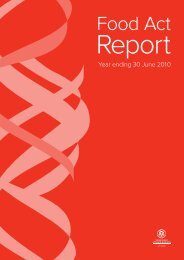Public Health and Communicable Diseases - SA Health - SA.Gov.au
Public Health and Communicable Diseases - SA Health - SA.Gov.au
Public Health and Communicable Diseases - SA Health - SA.Gov.au
Create successful ePaper yourself
Turn your PDF publications into a flip-book with our unique Google optimized e-Paper software.
avoidance strategies. To promote population healthby taking a ‘first-things-first’ preventative approach,beginning with a prison infection control program, 16would be analogous to removing the ‘pump h<strong>and</strong>le’that is driving the present preventable blood-borne virusepidemic in the prison environment.Prison infection control preventative strategies couldinclude:• Up-to-date post-exposure control plans that minimisethe potential of employee <strong>and</strong> inmate exposures toblood-borne pathogens, both occupational <strong>and</strong> nonoccupational;• Systems to ensure staff <strong>and</strong> inmates are vaccinatedas recommended by national immunisation guidelines<strong>and</strong> the outcomes <strong>au</strong>dited; 18• Establishing <strong>and</strong> enforcing respiratory isolation policiesto a community st<strong>and</strong>ard;• Ensuring that personal protective equipment such aslatex gloves <strong>and</strong> eye shields are available to both staff<strong>and</strong> inmates;• Environmental hygiene inspections by qualifiedenvironmental health officers in prison food cateringareas, health care centres <strong>and</strong> hair dressing locations;<strong>and</strong>• Establishing infection control committees thatinclude prison management, health care providers,environment health officers, housekeeping,food services <strong>and</strong> occupational health industrialrepresentatives.A prison settings infection control program wouldremove the ‘pump h<strong>and</strong>le’ from our correctionalsystem. It may be time to justify the introductionof a collaborative prison infection control program,underpinned by the hypothesis that our presentHepatitis C virus epidemic <strong>and</strong> its subsequent burdenof chronic disease will not be controlled unless newpartnerships are formed between the Justice <strong>and</strong> <strong>Health</strong>sectors. Some international jurisdictions are creatingcollaborations, based on scientific evidence to controlprison-mediated infections, <strong>and</strong> are consequentlyprotecting the general community from contagion. Inthese pragmatic jurisdictions, both human suffering <strong>and</strong>health costs have been reduced. 19,20References1 Department of <strong>Health</strong> <strong>and</strong> Human Services, Centres forDisease Control <strong>and</strong> Prevention (CDC). 150th Anniversaryof John Snow <strong>and</strong> the pump h<strong>and</strong>le. Morbidity <strong>and</strong>Mortality Weekly Report (MMWR). 2004;53(34):783.Available from: http://www.cdc.gov/mmwr/PDF/wk/mm5334.pdf.2 Joint United Nations Programme on HIV/AIDS. World<strong>Health</strong> Organization guidelines on HIV infection <strong>and</strong> AIDS inprisons. Geneva: World Heath Organization; 1993.3 <strong>Public</strong> <strong>Health</strong> Agency of Canada. Hepatitis C virustransmission in the prison/inmate population. Canada22<strong>Communicable</strong> Disease Report. 2004; 30(16):141-148.Available from: http://www.phac-aspc.gc.ca/publicat/ccdrrmtc/04vol30/dr3016ea.html4 Jurgens R. HIV/AIDS in prisons. Final report. Montreal.Canadian HIV/AIDS Legal Network; 1996. Available from:http://www.aidslaw.ca/maincontent/.htm5 Miller E. Hepatitis C infection in Australia: an ongoingepidemic. <strong>Public</strong> <strong>Health</strong> Bulletin South Australia. 2004;1:29-31.6 Hellard ME, Hocking JS <strong>and</strong> Crofts N. The prevalence<strong>and</strong> the risk behaviours associated with the transmissionof hepatitis C virus in Australian correctional facilities.Epidemiol Infect. 2004;132:4009-415.7 Toma_evski T. Prison health: international st<strong>and</strong>ards <strong>and</strong>national practices in Europe. Series 21. Helsinki Institute forCrime Prevention <strong>and</strong> Control (HEUNI) affiliated with theUnited Nations. Helsinki; 1992, 38.8 Australian <strong>Gov</strong>ernment Productivity Commission. Reviewof government services provision. Policy development, 7.9.Canberra: Corrective Services; 2004. Available from: http://www.pc.gov.<strong>au</strong>/gsp/rogs.html9 Butler T, Milner L. The 2001 New South Wales Inmate healthsurvey. Sydney: Corrections <strong>Health</strong> Service (NSW); 2003.10 Dolan K, Rouen DA. Evaluation of an educational comic onharm reduction for prison inmates in New South Wales. Int JForensic Psychol. 2003;1(1):138-141.11 World <strong>Health</strong> Organization. Ottawa charter for healthpromotion. <strong>Health</strong> Promot Int. 1986;1(4):i-v.12 Australian <strong>Gov</strong>ernment Productivity Commission. Review ofgovernment services provision. Canberra: Corrective Services.Available from: http://www.pc.gov.<strong>au</strong>/gsp/rogs.html13 Australian <strong>Gov</strong>ernment Productivity Commission. Reviewof government services provision. South Australiancomments, 7.33. Canberra. Corrective Services; 2004.Available from: http://www.pc.gov.<strong>au</strong>/gsp/rogs.html14 Kawachi I, Kennedy BP, Wilkinson RG. Crime: socialdisorganization <strong>and</strong> relative deprivation. Soc Sci Med.1999;48:719-731.15 Crofts N. A cruel <strong>and</strong> unusual punishment. Med J Aust.1997;166:116.16 Bick J. Infection control in the correctional setting.Infectious <strong>Diseases</strong> in Corrections Report. July/Aug2004. Available from: http://www.idcronline.org/archives/july<strong>au</strong>g04/article.html17 Nelles J, Fuhrer A, Hirsbrunner HP, Harding TW. Provisionof syringes: the cutting edge of harm reduction in prisons?Education <strong>and</strong> Debate. Brit Med J. 1998;317:270-273.18 National <strong>Health</strong> <strong>and</strong> Medical Research Council (NHMRC).The Australian immunisation h<strong>and</strong>book. 8th Ed. Canberra.Commonwealth of Australia; 2003.19 Lines R, Jürgens R, Betteridge G, Stöver H, et al. Prisonneedle exchange: lessons from a comprehensive review ofinternational evidence <strong>and</strong> experience. Montreal. CanadianHIV/AIDS Legal Network; 2004. Available from: http://aidslaw.ca20 Centres for Disease Control <strong>and</strong> Prevention. Prevention <strong>and</strong>control of infections with hepatitis viruses in correctionalsettings. Atlanta. Morbidity <strong>and</strong> Mortality Weekly Report(MMWR). 2003;52(RR-1). Available from: http://www.cdc.gov/mmwr/preview/mmwrhtml/mm5210a9.htm
















